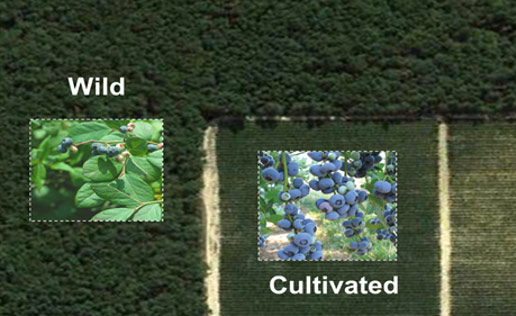Wild Hosts, Spotted-Wing Drosophila, and Blueberries
Dr. Cesar Rodriguez-Saona, Extension Specialist in Blueberry Entomology, Rutgers University
Dr. Pablo Urbaneja-Bernat, Post-doc, Entomology
Mr. Dean Polk, IPM Agent – Fruit
Spotted-wing drosophila (SWD) is a pest fly native to Southeast Asia; however, it has been introduced to many continents around the world including North and South America and Europe. Since its arrival in the United States in 2008, it has become an important agricultural pest of several small fruit crops including blueberries. Managing SWD in its introduced range can be difficult because it is able to feed on and breed on many hosts. Some of those wild hosts include wild cherry, dogwood, buckthorn, and honeysuckle. Along with providing food and breeding material, these wild hosts also provide overwintering sites.
In New Jersey, cultivated highbush blueberries are commonly grown near forest habitats where wild blueberry bushes are abundant. This means that the farmers’ crops are often right next to a potential large source of SWD that could attack their crops. A typical example of this situation can be seen in this aerial photograph of one of the fields that we studied (Figure 1). But until now it was not clear if this was happening—do nearby wild hosts increase the risk to a fruit crop like blueberries?
In a recent study published in The Canadian Entomologist, we investigated whether wild blueberries in these habitats could serve as a potential source of SWD flies to adjacent blueberry fields. In our field study, we monitored the activity of SWD during and beyond the harvest season (June through August). We did this for two years to help to ensure that our results were not just due to weather conditions in one year. We used traps baited with SWD lures. We placed the baited traps in the interiors of blueberry fields and in neighboring non-crop, forest habitats. We also tested whether the life cycles of the flies living on wild hosts was the same or different from flies living on cultivated blueberries.

We found that SWD is active in non-crop habitats throughout the harvest and post-harvest blueberry seasons. This means that farmers should monitor nearby forest areas to help assess their yearly risks. This is particularly important because we found that wild blueberries can serve as suitable alternative hosts for SWD oviposition and development during the ripening period of cultivated fruits.
Our work shows that SWD does well in forest habitats next to cultivated fields. In those areas their populations can increase to the point where adults could fly to neighboring blueberry fields and cause economic damage. Our work means that it is important for farmers and agricultural pest managers to look beyond their fields in their work to reduce the impact of this introduced pest.
Reference
Urbaneja-Bernat, P., Polk, D., Sanchez-Pedraza, F., Benrey, B., Salamanca, J., and Rodriguez-Saona, C. 2020. Non-crop habitats serve as a potential source of spotted-wing drosophila (Diptera: Drosophilidae) to adjacent cultivated highbush blueberries. The Canadian Entomologist. doi.org/10.4039/tce.2020.2.
